
The hidden psychological force that keeps people trapped with inferior products — even when yours is obviously better
A potential customer emailed me yesterday about their marketing struggles.
Their current agency delivers mediocre results, misses deadlines, and charges premium rates.
They know it. We know it. Everyone knows it.
Yet they’re still hesitating to make the switch.
So it isn’t about money or logistics.
It’s really divestiture aversion — our brain’s stubborn resistance to giving up what we already have.
This is the endowment effect’s evil twin.
We overvalue what we own, but there’s more. We actively resist divesting from our status quo, even when we’re aware that objectively better alternatives exist.
Your new customers have to choose to abandon their current solution.
That creates psychological friction you probably never considered.
Think about it: switching to YOUR freaking amazing product means admitting THEIR current choice was wrong.
That hurts the ego.
It means learning new workflows, explaining changes to their team, and risking that the grass isn’t actually greener. Then they’ll feel duped and look foolish.
Our ancient brain screams “better the devil you know.”
I see this everywhere in product marketing.
Guitar players might stick with buzzy Stratocasters rather than upgrade their pickups or try BzzzzKill — even when the buzz drives them crazy.
Companies limp along with clunky software instead of migrating to better platforms.
People tolerate subpar service providers for years rather than endure the “hassle” of switching.
In I Need That, I explain how our dog brain prioritizes loss avoidance over potential gains. Divestiture aversion makes this even stronger.
The solution isn’t just proving your product is better. It’s reducing the psychological cost of letting go.
Product Payoff: When Slack was competing against email for workplace communication, they didn’t just highlight their superior features. They created migration tools, offered white-glove onboarding, and positioned the switch as “evolution” rather than “replacement.” They made abandoning email feel like natural progress rather than admitting failure.
The divestiture strategy: Stop focusing only on your product’s benefits.
Address the specific pain of giving up their current solution.
Offer migration support, transition periods, or ways to gradually phase out the old while phasing in the new.
Position the switch as smart adaptation, NOT an admission of poor judgment.
Make the journey from their current state to your solution feel inevitable rather than disruptive.
Most importantly: Acknowledge what they’re gonna miss about their current solution and show how you solve that too.
What’s the biggest divestiture barrier your customers face when considering your product?
Hit that reply arrow and share how you’ve helped customers overcome switching resistance.
Or reach out to my team of product marketing strategists at Graphos Product.
